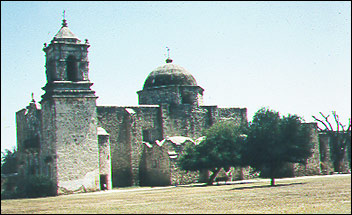Last updated: March 3, 2020
Lesson Plan
San Antonio Missions: Spanish Influence in Texas

- Grade Level:
- Middle School: Sixth Grade through Eighth Grade
- Subject:
- Literacy and Language Arts,Social Studies
- Lesson Duration:
- 90 Minutes
- Common Core Standards:
- 6-8.RH.2, 6-8.RH.3, 6-8.RH.4, 6-8.RH.5, 6-8.RH.6, 6-8.RH.7, 6-8.RH.8, 6-8.RH.9, 6-8.RH.10, 9-10.RH.1, 9-10.RH.2, 9-10.RH.3, 9-10.RH.4, 9-10.RH.5, 9-10.RH.6, 9-10.RH.7, 9-10.RH.8, 9-10.RH.9, 9-10.RH.10
- Additional Standards:
- US History Era 1 Standard 1D: Students understand comparisons between Africans, Europeans, and Native Americans who converged in the western hemisphere after 1492.
Curriculum Standards for Social Studies from the National Council for the Social Studies
Essential Question
Explore a group of 18th-century missions in modern San Antonio to learn about Spanish influence on native peoples and the patterns of Texas culture.
Objective
1. To explain the significant role that Spanish missions played in the early history of Texas and the Southwest;
2. To describe the psychological and cultural factors that led the Coahuiltecan (Kwa-weel-tekens) Indians to accept mission life;
3. To explain the role irrigation systems, such as acequias (ah-SAY-key-ahs), played in the development of Texas farmland and other arid areas;
4. To investigate the early religious history of their own community.
Background
Time Period: Early 18th Century
Topics: This lesson can be used in teaching units on Spanish conquests in the Americas or the early colonization of the United States.
Preparation
Most Americans know the clarion call "Remember the Alamo!" and have a hazy recollection that the "fort" originally had been built as a Spanish mission. What is less well known outside the Southwest is that the Mission San Antonio de Valero–the Alamo–was only one of a chain of missions strung along the San Antonio River. Established between 1718 and 1731, these missions were built not only to spread the faith of the conquistadors, but also to serve multiple foreign policy objectives for the Spanish government.
The famous Alamo is now a state historic site under the stewardship of the Daughters of the Republic of Texas and serves primarily as a reminder of the Texas Revolution of 1835-36. The other San Antonio River missions–Concepcion, San José, San Juan, and Espada–with some surrounding lands, constitute San Antonio Missions National Historical Park. By cooperative agreement with the Archdiocese of San Antonio, the mission churches remain active places of worship. Their importance, however, reaches far beyond their religious significance.
Lesson Hook/Preview
Missions were a major part of Spain's plan to establish and manage a colonial frontier in what is now the American Southwest. Settlement of this frontier has had significant and far-reaching effects on the development of the United States, both politically and culturally, effects that continue to be felt today. The missions were directly involved in the military, religious, and cultural development of the Texas frontier, and they influenced policy-making across the entire Southwest. The contribution of the missions to agriculture and commerce–they strongly influenced the development of the cattle industry–was of critical importance to the growth of the state of Texas and the San Antonio region. The mission buildings constitute a unique record of the architecture, art, and sculpture of the Spanish colonial period in Texas.
Procedure
Getting Started Prompt
Map: Orients the students and encourages them to think about how place affects culture and society
Readings: Primary and secondary source readings provide content and spark critical analysis.
Visual Evidence: Students critique and analyze visual evidence to tackle questions and support their own theories about the subject.
Optional post-lesson activities: If time allows, these will deepen your students' engagement with the topics and themes introduced in the lesson, and to help them develop essential skills.
Vocabulary
Spanish missions
presidio
conquistadors
Additional Resources
San Antonio Missions NHP
San Antonio Missions National Historical Park is a unit of the National Park System. The park's web pages provide photographs of the missions and also present information on the mission frontier, Spanish colonization, and the beginnings of San Antonio.
National Park Service Travel Itineraries
This Discover Our Shared Heritage online travel itinerary for South and West Texas provides information on more than 50 historic places listed in the National Register associated with Texas history, including Mission San José and the Espada Aqueduct.
The National Register of Historic Places online itinerary Places Reflecting America’s Diverse Cultures highlights the historic places and stories of America’s diverse cultural heritage. This itinerary seeks to share the contributions various peoples have made in creating American culture and history.
The Alamo
This website managed by the Daughters of the Republic of Texas is dedicated to encouraging historical research into the earliest records of Texas. It focuses on the Alamo's historic past, including its role as the Mission San Antonio de Valero.
The Handbook of Texas Online
The Handbook of Texas Online is a multi-disciplinary encyclopedia of Texas history, geography, and culture. It comprises more than 23,000 articles on people, places, events, historical themes, institutions and other topic categories. The Handbook of Texas Online is a joint project of The General Libraries at the University of Texas at Austin and the Texas State Historical Association.
The American Southwest
The American Southwest: A Guide to the National Parks and Natural Landscapes of Southwest USA provides photographs and descriptions of the San Antonio missions. Also featured are the missions of California.
Salinas Pueblo Missions National Monument
Salinas Pueblo Missions National Monument is another unit of the National Park System that protects several Spanish missions. The park's web pages provide detailed information on the once, thriving American Indian trade communities in this remote frontier area of central New Mexico. Included are essays on the Pueblos and the coming of the Spaniards, a history of Gran Quivira, as well as a trail guide.
